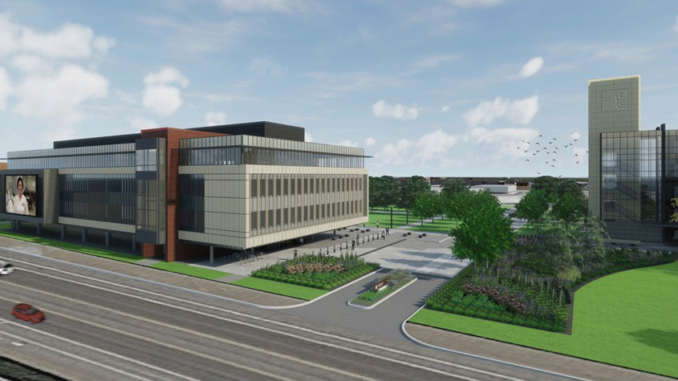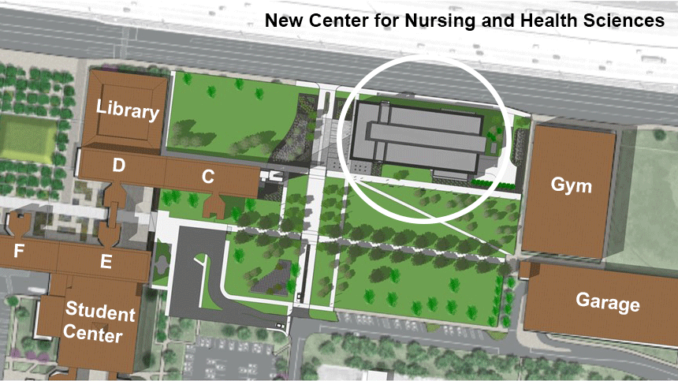
By Timothy Bold
The Scene staff
The look of the 50-year-old Forest Park campus will change dramatically over the next three years.
Plans call for demolition of A and B towers and construction of a new Center for Nursing and Health Sciences to meet a growing demand for workers in health-related fields.
“The footprint of the A and B towers will become green space,” said Forest Park Provost Larry Johnson. “… The new facility will be state-of-the art with resources that will give our students an edge in the job market.”
In January, the St. Louis Community College board of directors hired KAI Design & Build architectural firm to design the four-story, 96,000-square-foot center, which will house nursing, dental hygiene and eight other health-related programs.
The center will be located along Oakland Avenue, just north of where A and B towers are today. It will be made mostly of glass with brick accents.
Groundbreaking is scheduled for next March, followed by the demolition of A and B towers in 2019. The entire project is expected to cost $39 million.

“We’re selling the 300 S. Broadway building, and bonds are already in place for the financing of the (new center),” said STLCC Chancellor Jeff Pittman.
The Broadway building, commonly known as the Cosand Center, serves as STLCC district headquarters, across the street from Busch Stadium. Pittman will move to the Forest Park campus with an office on the fourth floor of the new center.
The Center for Nursing and Health Sciences is part of a “comprehensive, strategic plan” that the college has developed since he became chancellor in 2015.
“The development process was very participatory in nature, as we conducted 23 community forums to listen to stakeholder needs and also received over 1,200 survey responses from stakeholders discussing the education and workforce needs of the region,” Pittman said.
The Forest Park campus opened in 1967. It was designed by award-winning architects Harry Weese and his brother, Ben Weese, with collaboration from renowned landscape architect Dan Kiley, who also designed the original Gateway Arch grounds.
Not everyone is happy about upcoming changes at Forest Park. The Rev. Gregory Johnson, a historian, architecture buff and pastor of Memorial Presbyterian Church in St. Louis, wrote a piece for NextSTL.com that was critical of the college’s plans to tear down A and B towers.
“The towers and landscape were designed by three greats of mid-century architecture,” Johnson said in an interview. “Harry Weese and Dan Kiley were some of the best architecture modernists in North America.

“(Weese’s brother), Ben, contributed on the project and later became one of the ‘Chicago Seven,’ who formed the first generation of postmodern architects. It’s really quite remarkable, like getting Picasso, Mondrian and Jackson Pollack together on a design. These are the greats.”
NextSTL.com is an online magazine that “promotes smarter development and civic engagement.” Johnson’s piece appeared in the April 14 issue.
Reactions from readers were mixed. Some didn’t like the idea of destroying architectural history. Others implied that the Forest Park campus is unattractive.
“I find it hard to imagine that anyone would consider tearing these towers down,” Johnson said. “Demolition would poorly reflect on the values of St. Louis Community College and leaves lots of us scratching our heads, wondering if they know what they have.”
Pittman acknowledged the architectural value of the Forest Park campus but defended the redevelopment plan.
“The towers were constructed over 50 years ago and are outdated on several fronts,” he said. “To begin with, the towers are very energy inefficient. We’re replacing them with a gold LEED-certified building.”
LEED stands for Leadership in Energy and Environmental Design. Certified buildings use less water and electricity, reducing greenhouse emissions.
The new center also will contain up-to-date classrooms and equipment and lots of open areas for more programs.
Karen Mayes, director nursing, agrees with Pittman on the need to spruce up Forest Park to attract new students.
“The looks of our facility have been holding us back since I’ve been on campus, since 2003,” she said. “The new building will be very visually appealing. I think it’s going to bring a positive image to the community.”
STLCC publishes an annual St. Louis Workforce Report, which includes information from more than 1,000 employers in 15 regions across Missouri. The last report indicated that allied-health workers are in strong demand.
The report cites the Missouri Economic Research and Information Center and U.S. Department of Labor, which project that by 2024, the state will need 3,284 more registered nurses and 1,533 nursing assistants. Employers placed nearly 11,000 advertisements for nursing job online in the past year, according to the report. The state’s projected growth rate for healthcare jobs is 11 percent, more than double the 5 percent rate for all other industries.
“This is the reason why the college has elected to develop a state-of-the-art Center for Nursing and Health Sciences to assist in meeting the critical-skills gap with allied-health employers,” Pittman said.
